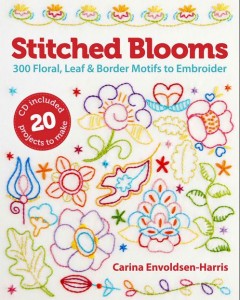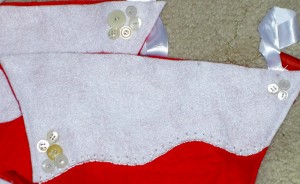
Stitched Blooms: 300 Floral, Leaf & Border Motifs to Embroider by Carina Envoldsen-Harris. Published by Lark Crafts (ISBN: 978-1-4547-0425-6)
Thanks to Lark Crafts for sending me this book to review. It isn’t on Goodreads yet, but I am sure it will be there soon.
This is a beautifully designed book. I love the colors and details such as the scalloped edging on some of the pages. I also like the photography. The pictures fit the sections in which they are placed and in some cases are cleverly used to illustrate a point.
The book comes with a CD that purports to have all of the pattern pieces full sized. I didn’t look at the CD, but imagine Lark would not lie to us. 😉 The author writes in the introduction (pg.7) “You can use the motifs straight out of the book pages or take advantage of the enclosed CD, which has al of the motifs in black and white. Adjust and combine them however you like, by changing the size of the motifs or by adding or removing elements. Step-by-step instructions are included for downloading and sizing…so you can stitch them to nearly anything…”
The above makes me like this book. I like the fact that the author is encouraging readers to use the book as a jumping off point. She implies that you can re-size the motifs to make them fit your garment or item and she encourages reader-makers to manipulate her designs to create new motifs. This is such a refreshing point of view. I love it that she does not think (imply?) that her designs or projects are the end of the story. Yay! An author (and a publisher who let her) who realizes that her readers have brains and creativity of their own.
The tone of this book is very informal. It seems to match the tone of the author’s blog.
Ms. Envolsen-Harris gives a bit of a color theory lesson (pg.9). In the first part she talks about mixing colors, which doesn’t seem that relevant to a book about embroidery, but I kept an open mind and was rewarded when the author talked about the impossibility of mixing embroidery floss. She brings up an excellent point when she says “No matter how tightly you twist them together, red floss and yellow floss will not turn orange-they will always remain red or yellow. But they may look orange from some distance and that is very important to keep in mind.”
Yes, it is important to keep in mind. Colors next to each other look different than they would next to other colors. For example if a kelly green is a next to blue, it will look different when placed next to a sunshine yellow. Try it. It is good for quiltmakers to keep in mind. there are color wheels included in this section, so you can use them if you don’t have another one.
Carina talks about the different words and concepts related to color such as value, warm and cool, complementary, etc (pg.10-11). This is a nice section, because she uses embroidery floss to illustrate the examples. At the end of the section, the author says something that is very important “Being ‘good’ at putting colors together can be practiced. The more you work with colors, the better you will get at combining them. You can train yourself by challenging the color choices you make. ” (pg.12). This is so important. If you think you are not good at color, read that part in this book (link above to purchase!) and remember it. If you won’t listen to me, perhaps you will listen to some who got published. Color is a process and you have to practice.
She talks about Fabric & Thread (pg.14-16), Embroidery Tools (pg.17-21), Working with Motifs (pg.22-27), and there is a Stitch Glossary (pg.28-33). The layout and colors used in the Stitch Glossary make me want to get out a needle and try out the motifs. The Embroidery Tools section includes advice on stabilizers and several paragraphs on needles.
There are 20 projects in this book. The projects include clothing, embellishing store-bought clothing, home decor, personal items, accessories, a sewing case, linens, toys, and a quilt! One of my favorites is a frame. The projects in here are different and interesting. I didn’t see the word easy or simple once, but the positive tone of the book implies that everyone can pick up a needle and embroider. I am going to try making the needle case.
I looked through the book from back to front and saw the motif library (pg.102-125) first. My first thought was that many of the motifs would make fabulous applique’ designs or free motion quilting designs.
I would recommend this book for a a source of inspiration even if embroidery is not something you plan on taking up.
You can find Carina’s blog at http://carinascraftblog.wardi.dk/. There are additional embroidery designs to buy, which are accessible via the blog. (N/A)

